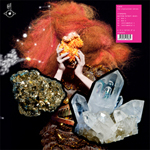2ème single de Biophilia
i want to ask you a favour : ppllleeeasseeeeee ?!! if you listen to cosmogony , do it with headphones . it has its bottomhalf missing otherwise ... warmth
Björk
That particular sound, Cosmogony, I guess after watching documentaries about string theory, it was sort of a personal joke, maybe my sense of humor is local and a lot of people might not find it funny because they are talking about Big Bang being 20th Century and string theory being so 21st Century. Big Bang theory felt like a creation myth that is 100 years old. Me and my friends, probably after a few glasses of something, were sort of thinking “I guess all creation myths at the time of their making were science”. I’ll bet the pharaohs thought pyramids and mummies were the future – that was pretty science fiction. 3000 years later it is just mythology and the creation myth. In this song you have 4 verses. The first verse is the American native creation myth, next verse is Sanskrit creation myth, the 3rd verse is Aboriginal creation myth and the 4th verse is Big Bang theory. But it is also tongue and cheek. It is Monty Python. I guess it doesn’t translate as well in print.
interview StreetDateRadiio.com
Une version Instrumentale épurée de la chanson est intégrée à l’application pour iPad intitulée Solar System permettant de découvrir le système solaire et son fonctionnement du bout des doigts.
En octobre 2011, Björk a organisé un concours dont le but etait de créer un nouveau vers sur le thème de la chanson. Le gagnant , eitch a composé le vers suivant :
« and they say : back then our universe
was immensely hot, and packed into a point
the size of a dot, an atom, a quark, a string
that shook and became the world we know »
Il a été interprété par bjork au concert du 18 février 2012 au New York Hall of Science
Pages du manual
Présentation de la chanson dans l’application Biophilia
when the silver Fox creates the world by singing and dancing in the lyrics of cosmogony, it puts music at the centre of cosmological creation . Cosmogony, biophilia’s "mother" song and app is inspired by the ancient idea that the beauty and orderliness of the cosmos and of musical sound are similar. Knowing that she wanted the lyrics to be about creation myths, and the idea that the big bang is our own civilisation’ s creation story , bjork asked her long-time friend , the poet sjon, to translate her ideas into words —a collaborative process bjork used on other album "theme" songs, such as bachelorette , isobel , and oceania.
In cosmogony, modern cosmological big bang theory appears alongsi de native
american , Chinese and australian aboriginal creation myths , revealing the different ways humans have tried to understand their origins and the wonders of the universe.
Analyse par Nikki Dibben
« this song is the "music of the spheres" song for me ... so It ’ s all about copper and rotating things and harmony and equilibrium and the universe and where there’ s a place for every little thing and we’ re all taken care of. » — bjork
bjork’s inspirations for cosmogony combine ancient philosophy with recent scientific discoveries . the notion of ’music of the spheres’ proposed that the relationships between the movements of sun, moon and planets were a kind of music - not a literal music you could hear . but a mathematical and harmonic idea . In 17th century europe, when these ideas were current, sun, moon and planets were believed to revolve around the earth in fixed ratios. And it was these proportions that were thought to correspond to the ratios of musical intervals (the ’’step" between different musical pitches). Orbital ratios and musical harmonies were thought similar because the relationship between two pitches within a musical harmony can be expressed as the ratio of their
frequencies — the rates at which the movements of air molecules cause our ear drums to vibrate .
bjork updates the notion of ’music of the spheres· for the 21st century . First by connecting with its holistic ideal . And second. by drawing on recent scientific discoveries . At first glance biophilia might appear nostalgic due to its references to 19th century naturalist values — when working with nature meant you had to go "back to nature" and reject industrialisation . But biophilia’ s embrace of the sciences and digital technology suggests that with the 21st century comes an opportunity to go, in bjork’ s words. forward to nature . and because of discoveries wrought by the very industrial revolution which was the bane of naturalists, " evolve past it —move from low teen to high teen . And work with nature through such things as harnessing natural resources through solar panels. wind farms, and tidal energy. "
So to understand biophilia it’ s important to remember the holistic imperative behind the ’music of the spheres" — to unite everything and to find the harmony that exists when you do that . This is in stark contrast to the kind of thinking which subsequently came to dominate western thought which rejected or devalued certain kinds of concepts and practices (for example. emotion, spirituality, alternative medicine) .
On a more literal level, bjork updates the notion of "music of the spheres" to include recent discoveries such as the solar winds. The stream of charged particles emitted from the sun, through her arrangement for choir :
« It ’ d be really nice if you were making a music of the spheres pop song 21st century to at least include what was discovered in the 21st century. » — bjork
For bjork, the sliding chorus which starts and ends the song (represented in the animation as rising circles), and the pitch bends in the brass (represented as bent bars), represent curves — the orbits of planetary objects. You can also hear them as pitch in its "raw" form —a frequency continuum. rather than the subdivisions into steps which make up tonal systems all over the world— drawing
an analogy between human construction of musical systems from raw parameters of sound , and the idea of cosmological creation .
Like other tracks in biophilia, the ideas behind cosmogony can be heard in its musical sounds and structures . The song itself can be thought of as a system in equilibrium due to its logical and predictable musical patterns : it alternates regularly between verse and chorus, repeats a small number of closely related chords, and the chorus repeats the same pattern of intervals starting on a different scale step each time (what’s called a ’melodic sequence’). At 60 beats per minute the slow pulse of the music is appropriate to the regal theme and feels comfortable , perhaps because it subdivides at 120 bpm —a pace at which humans tend to move.
Bjork likens the speed of the music to the regular swing of a pendulum —a device which embodies the earth’ s gravitational pull and links the music to the idea of planetary orbits. the animation evokes this idea by representing bjork ’ s singing voice as a circle which moves along a line and subtly shifts in distance like a planet tracing its orbit .
The instrumentation evokes the majesty associated with planetary systems. The theme of bronze and copper which runs through biophilia appears here in the sound of french horns . But their sound might make you think of ’ dignity’ due to their history of use in fanfares and the military, or even ’heroic space exploration’ due to their use in hollywood films such as Apollo 13 and the Right
Stuff . Together with the wordless choir. which evokes the idea of heaven through its use in religious contexts. These musical associations are devotional —about worship and wonder rather than military might and human endeavor .
Crédits
Musique
Musique : Björk
Paroles : Sjón et Björk
Arrangements des cuivres : Björk
Transcriptions pour les cuivres : Matt Robertson
Arrangements des choeurs : Björk
Beats : Björk
Programmation des beats : Björk et Damian Taylor
Ingénieurs du son : Damian Taylor, Sveinn Kjarttansson, Curver, David Bracey, Addi 800 et Andy Baldwin
Mixage : Björk, Curver, Addi 800,et Mandy Parnell
Production : Björk
Graphisme
Photo : Inez+Vinoodth
Design : M/M (Paris)
Stylisme : Threeasfour
Remix
| Cosmogony (El Guincho remix) | 06:22 | Pablo Diaz Reixa |
| Cosmogony (Matthew Herbert Remix 1) | 05:04 | Matthew Herbert |
| Cosmogony (Matthew Herbert Remix 2) | 04:15 | Matthew Herbert |
| Cosmogony (Matthew Herbert Remix 1 Intrumental) | 05:04 | Matthew Herbert |
| Cosmogony (Matthew Herbert Remix 2 Intrumental) | 04:15 | Matthew Herbert |
| Cosmogony (Serban Ghenea Mix) | 04:49 | Serban Ghenea |
Versions utilisées dans les App
| Cosmogony (Score version) | 04:37 | App |
| Cosmogony (Animation version) | 04:53 | App |
| Cosmogony (Instrumental) | 04:34 | App |































